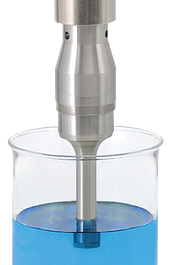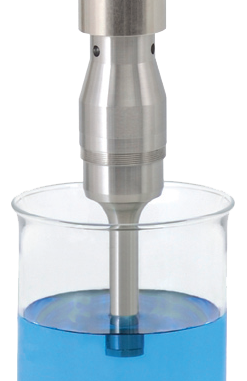The sonication method is used to break up irreversible magnetic bead aggregates when they are generated during various steps of the production process. However, sonicating a large volume is not a straightforward process. To set up a largevolume sonication, you must choose the proper probe, the power, and the conditions, but choosing and determining these things can be tricky.
This post is about resuspension techniques, such as the sonication method, and how they can solve magnetic bead aggregation. If you are interested in this topic, download our free ebook The basic guide for resuspending magnetic beads:
One very important thing you must ask yourself is ‘why do I have aggregates in the first place?’. There are two possible causes of irreversible aggregation that you need to investigate:
1. Did you properly block the exposed hydrophilic bead surface after coating?

During the production process, you will coat the beads, but you will not always be able to coat their entire surface. If you have not blocked the parts of the beads not covered by your antibodies or antigen, these exposed surfaces can react with other proteins or with the protein on neighboring beads. If you are using the correct blocking reagent, you will reduce auto-aggregation, thereby reducing non-specific background reactions.
Since avoiding aggregate formation altogether greatly simplifies re-suspension, it is worth trying different blocking reagents to find the optimal re-suspension conditions (e.g. BSA, Tween 20, Triton-X 100, etc.).
2. Are you applying excessive magnetic force when separating the beads?
The magnetic force in classical separation systems decreases quickly with distance from the magnets. Because of this, technicians need to generate extremely high forces in the magnetic bead retention areas in order to have enough force to capture beads far from the magnets. In addition, since the forces are weak far from the magnets, separation times are long, causing the beads in the retention area to experience high magnetic forces over long periods of time. High magnetic forces can cause irreversible bead aggregation in spite of optimal blocking techniques.
Modern homogeneous biomagnetic separation systems, however, generate the same force in the entire working volume, thus decreasing the time for bead recovery, increasing the amount of beads recovered and decreasing the forces the beads experience in the retention area over time. Gentler retention forces, larger retention areas and the shorter exposure time to magnetic forces can result in an avoidance of irreversible aggregation altogether.
If you can avoid irreversible aggregation, mixing via homogenization is the only technique necessary to resuspend the beads allowing for a simpler, more predictable process that is easy to scale up.
Don't forget to check these posts from our blog in order to get a deeper insight into magnetic bead resuspension:
- Three Questions to Help Decide What Technique to Use for Magnetic Bead Mixing and Homogenizing
- The 2 Most Popular Magnetic Bead Mixing and Homogenizing Technologies
- Mixing and Homogenizing Magnetic Beads without Touching the Suspension






